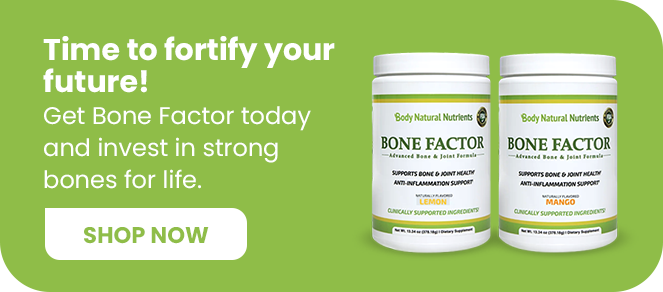Welcome to your journey of discovering the secrets to strong bones! Keeping your bones healthy is a lot like building a solid house – without the right materials, things can fall apart.
If you’ve ever felt worried about bone breaks or weakness as you or loved ones get older, this information is for you.
Did you know that our bodies are built with 206 bones? They do amazing work, from letting us dance and jump to protecting our brain and heart. This blog will show you ways to keep every single bone in tip-top shape so they can keep doing their job well.
We’ll share some easy steps and smart choices that make it simple to care for your skeleton.
Ready for healthier bones? Let’s start building strength from within!
Key Takeaways
- Eating a diet rich in calcium and vitamin D is key for good bone health. Foods like dairy, leafy greens, and fish are excellent choices to boost bone density.
- Regular weight – bearing exercises such as walking, dancing, or lifting weights help strengthen bones and decrease the risk of osteoporosis and fractures.
- The Bone Health & Osteoporosis Foundation offers personalized tools to manage bone health that include educational materials and guidelines tailored to individual needs.
- Avoiding smoking and excessive alcohol can protect your bones. Combining this with an active lifestyle and balanced nutrition greatly reduces the risk of bone-related issues.
- Proper sun exposure aids in our body’s natural production of vitamin D which is essential for maintaining strong bones throughout life.
Understanding Osteoporosis
Osteoporosis is a condition characterized by weak and brittle bones, often resulting in fractures. It is important to understand the risk factors, diagnosis, and management of osteoporosis in order to take proactive steps towards good bone health.
Risk factors for osteoporosis
Certain factors increase your risk of developing osteoporosis, a condition that weakens bones and makes them more likely to break. Genetics play a part—having a family history of the disease might mean you’re more prone to it yourself.
Age is another crucial factor; the older you get, the higher your risk since bone density naturally decreases over time. Women are at greater risk than men, especially after menopause when estrogen levels drop significantly.
Lifestyle choices also make a big difference in maintaining bone strength. If your diet lacks enough calcium or vitamin D—which help keep bones strong—you may be putting yourself at greater jeopardy for osteoporosis.
Similarly, leading a sedentary lifestyle without regular exercise can contribute to faster loss of bone mass. Avoid smoking and excessive alcohol consumption too since these can hinder the body’s ability to build new bone.
Moving on from understanding risks, let’s explore how diagnosis and management strategies can help in dealing with osteoporosis effectively.
Diagnosis and management
Diagnosing osteoporosis involves a bone density test, which measures the mineral content and strength of bones. This non-invasive procedure helps identify low bone density and assess fracture risk.
Management includes lifestyle changes, such as a diet rich in calcium, vitamin D, and K. Regular weight-bearing exercise can help maintain bone mass. Treatment options may include medications that reduce the risk of fractures by increasing bone density.
Understanding the importance of early diagnosis and implementing effective management strategies is crucial for preventing fractures and maintaining overall bone health. Now let’s explore the personalized resources available for patients seeking to optimize their bone health.
Understanding the importance of early diagnosis and implementing effective management strategies is crucial for preventing fractures and maintaining overall bone health. Now let’s explore the personalized resources available for patients seeking to optimize their bone health.
The Importance of Following Your Path to Good Bone Health
Learn about the Bone Health & Osteoporosis Foundation and how it provides personalized resources for patients. Discover the new patient-centered tool for osteoporosis prevention and management.
Introduction to the Bone Health & Osteoporosis Foundation
The Bone Health & Osteoporosis Foundation provides personalized resources for patients and offers a new patient-centered tool for osteoporosis prevention and management. Understanding the importance of bone health is crucial for overall well-being, especially when diagnosed with osteoporosis.
Education on maintaining bone density through diet, exercise, and lifestyle factors plays a pivotal role in preventing fractures and promoting strong bones throughout life.
Incorporating leafy greens, fish, dairy products rich in calcium and vitamin D is essential to increase bone density. The foundation’s mission aligns with the vision for the future – a framework for action to promote bone health awareness and educate individuals about its significance.
The new patient-centered tool for osteoporosis prevention and management
Empowering individuals with the knowledge and resources to take charge of their bone health, the Bone Health & Osteoporosis Foundation introduces an innovative patient-centered tool for osteoporosis prevention and management.
This comprehensive solution provides personalized educational materials, exercise plans, dietary guidelines tailored to individual needs, ensuring that patients have access to a range of tools aimed at promoting strong and healthy bones.
Armed with this new tool, patients can make informed choices regarding their bone health journey. By offering targeted resources specific to each patient’s needs, such as calcium intake recommendations or personalized exercise regimens, this user-friendly tool facilitates proactive steps towards preventing fractures and managing osteoporosis effectively.
Personalized resources for patients
Accessing personalized resources can be invaluable for individuals dealing with bone health issues such as osteoporosis. The Bone Health & Osteoporosis Foundation offers tailored tools and information to help patients understand their condition better and make informed decisions.
By utilizing these resources, individuals can gain a clearer understanding of preventive measures, treatment options, and lifestyle adjustments necessary for maintaining healthy bones.
This personalized approach empowers patients to take an active role in their bone health journey, leading to improved overall well-being.
Furthermore, individuals can explore educational materials provided by the foundation to enhance their knowledge about bone health and osteoporosis management. These resources cover essential topics like bone density testing, diet recommendations for optimal bone health, vitamin D levels, exercise guidelines for strengthening bones, and awareness about preventing fractures.
Tips for Maintaining Healthy Bones
Maintaining healthy bones is essential for preventing osteoporosis and bone fractures. A balanced diet, regular exercise, and lifestyle adjustments can help promote strong and healthy bones.
Diet and nutrition
Consuming a diet rich in calcium, vitamin D, and K is crucial for maintaining good bone health. Good sources of calcium include dairy products, almonds, broccoli, kale, canned salmon with bones, sardines and soy products like tofu.
Incorporating leafy greens, fish, and dairy into your diet can help increase bone density. It’s important to remember that external factors such as diet play a critical role in promoting strong bones throughout life.
Moving on to the next section on “Physical activity and exercise”, let’s explore how staying active contributes to maintaining healthy bones.
Physical activity and exercise
Regular physical activity is crucial for maintaining good bone health. Weight-bearing exercises like walking, jogging, and dancing help to strengthen bones and reduce the risk of fractures.
Engaging in muscle-strengthening activities such as weightlifting or resistance training also contributes to overall bone strength. Additionally, activities that improve balance and coordination can lower the likelihood of falls and related fractures.
By incorporating a variety of exercises into your routine, you can actively support your bone health while enjoying the numerous benefits of an active lifestyle.
t’s important to remember that physical activity at any age plays a vital role in building strong bones. Whether it’s through organized sports, recreational activities, or simply including more movement in daily routines such as taking the stairs instead of using an elevator, physical activity provides significant support for bone health throughout life.
Lifestyle factors
To maintain strong and healthy bones, lifestyle factors play a crucial role. Incorporating a balanced diet rich in calcium, vitamin D, and K is essential for bone health. Foods such as dairy products, leafy greens, fish, almonds, and soy products can help increase bone density.
Along with a nutritious diet, engaging in regular physical activity is imperative to maintaining bone mass and preventing bone loss. Moreover, avoiding smoking and excessive alcohol consumption are important lifestyle choices for promoting overall bone health.
By integrating these lifestyle factors into daily routines, individuals can actively work towards preventing osteoporosis and reducing the risk of fractures.
FAQs
1. Why is a healthy diet important for bone health?
A healthy diet rich in calcium and vitamin D supports strong bones, helping to prevent osteoporosis and fractures.
2. How does exercise contribute to stronger bones?
Regular weight-bearing exercises like walking or lifting weights help build and maintain bone strength, an essential element in osteoporosis prevention.
3. What resources are available for learning about bone health?
Bone health resources include osteoporosis education materials, information on preventing bone fractures, and guidance on maintaining a healthy lifestyle.
4. Can we treat osteoporosis effectively?
Yes, there are multiple treatment options for osteoporosis that can slow down bone loss and reduce the risk of fractures with proper medical guidance.
5. Is awareness around exercising for bone health necessary?
Absolutely! Osteoporosis awareness programs often emphasize the importance of exercise for bone health to encourage individuals to take proactive steps towards strengthening their bones.
Conclusion: Taking Action for Strong and Healthy Bones
Taking charge of your bone health is crucial for a fulfilling life. Adopting a balanced diet and staying physically active are vital components for strong bones. Understanding the significance of proactive measures will pave the way for robust and healthy bones.
Making informed choices today contributes to a sustainable foundation for overall well-being. Committing to your path to good bone health ensures an active and vibrant future.



